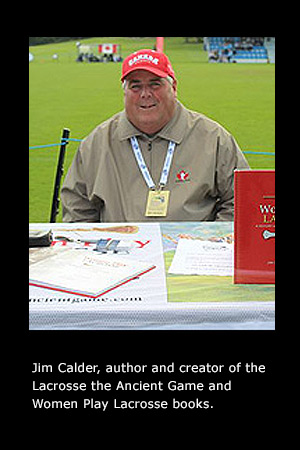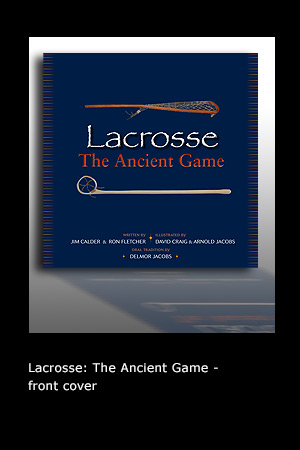LACROSSE: THE ANCIENT GAME - AUTHORS

JIM CALDER
Publisher and co-author has over forty years of experience in lacrosse. He has been involved on the local level beginning in Baldwin, L.I. and currently in Scarborough, Ontario; nationally with Hobart College and on an international level with Team Canada. He has been player, coach, manager and builder of the game.
SAMPLE TEXT
He looked back towards his home. The planks of hickory he had brought back yesterday rested against the log wall. He knew his wife and daughter would not have touched them. They knew the power they carry as women would affect the holistics of the wood. The Creator’s game was in the men’s realm. He looked forward to starting work on the stick………………
…………He selected one of the hickory lengths and held it in his hands while he meditated upon it. He began to see the shape of the stick, and the stick saw the player, and so the team began, the player and the stick. He wedged the stave between his legs, the top pointing away from him. His two-handled drawknife was freshly sharpened and ready for use. With both hands, he pulled the knife along the edge between the bark and the wood, shaving the top part of the stick clean.
Excerpt from “The Stickmaker” Chapter by Jim Calder in “Lacrosse – The Ancient Game”
An expatriate Montrealer named John R. Flannery would prove as instrumental in igniting interest in the lacrosse in America as George Beers had been in Canada.
Flannery was born in the right place at the right time. …….in the city that would become the first hotbed of the game for non-Native players and fans.
Flannery…….. proved to be a natural at lacrosse. By the age of seventeen, he was already being touted as a top player of the game and was the top player for the Shamrocks L.C. It must have been something to see him charge a net protected by Montreal L.C. goaltender and lacrosse icon George Beers, seven years his senior. …….. But sometime in the mid-1870s, at the height of his playing career, Flannery was faced with a life-altering decision when he was offered work at Standard Oil in Boston, as well as a key role on that city’s Union Lacrosse Club. Flannery accepted the invitation and soon packed his bags and sticks and moved south. The move would change not only John Flannery’s life, but also the future of lacrosse in North America.
Excerpt from “The Early Days of Lacrosse in the United States” Chapter by Jim Calder in “Lacrosse – The Ancient Game”

RON FLETCHER
Co-Author is author of Over the Don and The Humber: Tales of a Canadian Heritage River – two historical books on Toronto’s defining rivers. He is a founder and officer of various Toronto Historical Societies, an historical lecturer and has a Masters Degree in Comparative Education.
SAMPLE TEXT
To ensure the spirits would take a close interest in the game, the medicine man insisted that correct procedures be followed. He made sure that the men were among the Bear Clan’s most fit. He instructed the players to sleep separate from their wives before the match. He took them to the place by the creek where they splashed themselves with water in purification rituals. The bark of the red willow had been gathered carefully and made into a cleansing drink.
The crowd cheered their favorites as the players took to the field. These men were the pride of Ossossane. Some, seeking greater speed and agility, had tied bird feathers to their sticks. Others, hoping for additional strength, had affixed bear claws. One player had an owl’s beak for clearer eyesight, another a bat’s wings for the power to dart to and fro. All had smeared their arms and loins with the shaman’s ointments. Children in the crowd carried miniature lacrosse sticks, hoping some day to follow in the steps of their heroes.
Excerpt from “Brebeuf” Chapter by Ron Fletcher in “Lacrosse – The Ancient Game”
It was June, but a cold, fresh wind blew in from the Straits of Mackinac and whistled through the open gate of palisaded Fort Michilimacinac. The women gathered by the wooden gate wrapped their blankets more tightly around themselves. But warmth was not the only reason for this action. Hidden beneath the blankets were weapons of war: tomahawks, war clubs and knives. A game of lacrosse — the “little brother of war” — was about to begin, and this game would have dire consequences for some of its spectators.
Excerpt from “Fort Michilimackinac” Chapter by Ron Fletcher in “Lacrosse – The Ancient Game”

DELMOR JACOBS
Oral Tradition. Delmor is a Cayuga faithkeeper at Six Nations Reservation and has 45 + years of involvement in lacrosse as a player, coach and builder.. He has represented his people as a player at the world level. Delmor provides some of the most important stories of the Haudenosaune Ongwehone people regarding the Creator’s Game and has insured accuracy of the text from a First Nations perspective.
SAMPLE TEXT
There is a game that is deeply engrained in our culture, and we call it “the Creator’s game.” Non-Native people call it lacrosse. I will explain why we call it the Creator’s game and the reasons why it is so important to the Ongwehonwe Haudenosaunee.
The game stretches from cradle to grave for our people. Many young boys are given a small wooden lacrosse stick when they are in the cradle. The stick is there at the other end, too. I have been to two funerals in the last little while, and both men were buried with their lacrosse sticks in their caskets.
Back when Uncle and Creator played, they did so for six days with no one winning. So the Creator came up with another game. It was a stickball game, and the only rule was that the players couldn’t touch the ball with their hands. A stick was used between the hand and the ball. Originally it was supposed to be a small stick, just long enough to keep the hand from the ball, but enabling control of the ball. A player would use his body to block the other players from the ball. So it was very important to have a healthy body in order to play the game. This was the beginning of lacrosse.
Within the Cayuga Nation, we play a lacrosse game every springtime, in the middle of April. Our Creator and the Thunder Entities all play the game at that time. We designate a ceremonial game to honor them, give thanks and as a way of entertaining them. Outside the longhouse, we place the sticks all in a circle, and in the middle of the circle we burn tobacco and we thank the Thunder Entities again for coming to clear the air. Without this game the whole universe would be in chaos.
The game is to seven goals. The goals are outlined, and the game is played with wooden sticks. When the seventh goal is scored, the game is over. The length of game depends on the enthusiasm of the players and the influence of the Thunder Entities, since it is for their entertainment.
When a thunderstorm goes through, you can feel the rough and tumble, like a lacrosse game. And also, after the rain goes by, it is so clean. Everything is refreshed with the rain and it is usually cooler. We are also told that the lightning and the thunder keep fierce creatures under the earth.
Excerpt from “The Words of a Cayuga Faithkeeper” oral tradition by Dao Jao Dre (Delmor Jacobs) in “Lacrosse – The Ancient Game”
BUY THE BOOK
Payment Instructions
Payment for any of the books can be made through e-transfer. Please indicate the book(s) you are purchasing to "james.calder2@sympatico.ca" or by cheque to "T.E.C. Inc.". Cheques should be mailed to:
T.E.C. Inc.
3085 Kingston Road,
Unit 106
Toronto, Ontario, M1M 1P1
Allow up to 3 weeks for delivery.
Shipping rates are for Canada and US only.
For International deliveries please contact us at:
james.calder2@sympatico.ca
